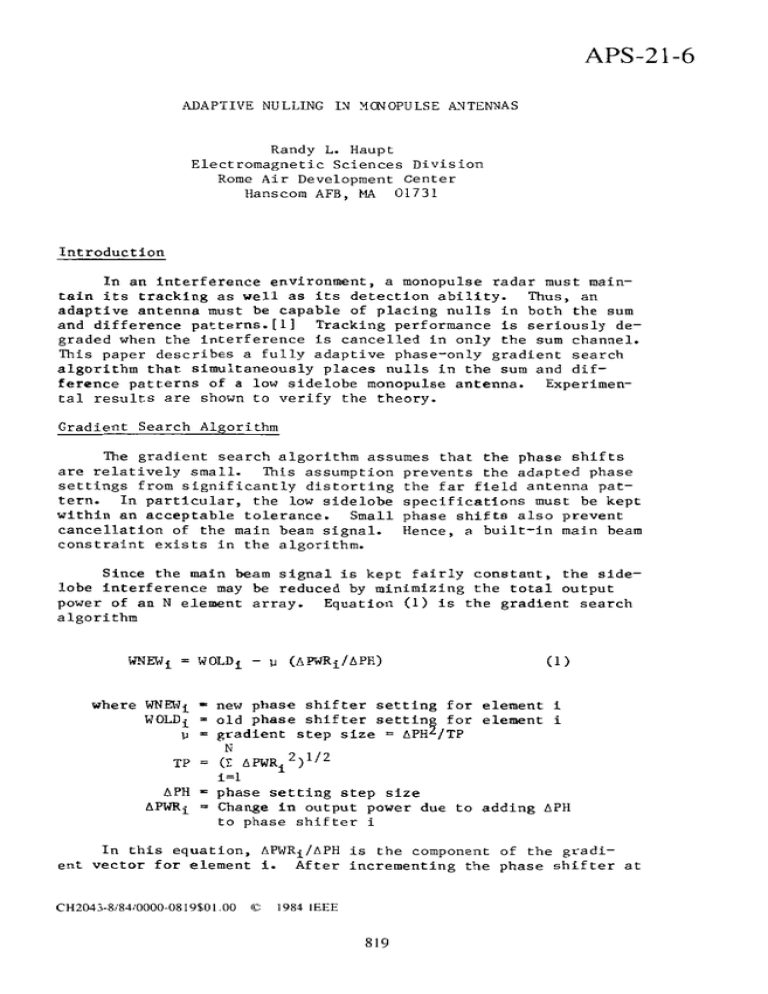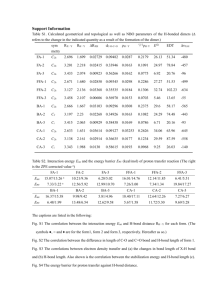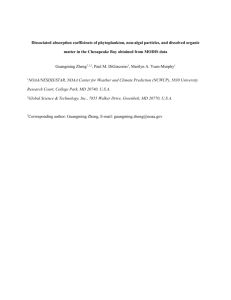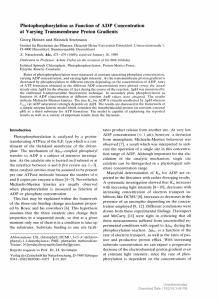APS-2 IN L.
advertisement

APS-2 1-6 ADAPTIVE NGLLING IN YCNOPULSE K'ITTENNAS Randy L. Haupt E l e c t r o m a g n e t i cS c i e n c e sD i v i s i o n Rome Air DevelopmentCenter Hanscom AFB, MA 01731 Introduction I n a ni n t e r f e r e n c ee n v i r o n m e n t , a monopulse r a d a r mustmaini t s d e t e c t i o na b i l i t y . Thus, a n t a i n i t s t r a c k i n ga sw e l la s a d a p t i v ea n t e n n a must be c a p a b l e of p l a c i n g n u l l s i n b o t h t h e sum i s s e r i o u s l y dea n dd i f f e r e n c ep a t t e r n s . [ l lT r a c k i n gp e r f o r m a n c e sum channel. graded when t h e i n t e r f e r e n c e i s c a n c e l l e d i n o n l y t h e This p a p e rd e s c r i b e s a f u l l ya d a p t i v ep h a s e - o n l yg r a d i e n ts e a r c h algorithmthatsimultaneouslyplacesnullsinthe sum and d i f f e r e n c ep a t t e r n s of a low sidelobemonopulseantenna.Experiment a l r e s u l t s a r e shown t o v e r i f y t h e t h e o r y . GradientSearchAlgorithm The g r a d i e n t s e a r c h a l g o r i t h m a s s u m e s t h a t t h e p h a s e s h i f t s This a s s u m p t i o np r e v e n t st h ea d a p t e dp h a s e a r er e l a t i v e l ys m a l l . settingsfromsignificantlydistortingthefarfieldantennapatt e r n .I np a r t i c u l a r ,t h e low s i d e l o b es p e c i f i c a t i o n s mustbekept w i t h i na na c c e p t a b l et o l e r a n c e .S m a l lp h a s es h i f t sa l s op r e v e n t c a n c e l l a t i o n of t h e main beam s i g n a l . Hence, a b u i l t - i n main beam c o n s t r a i n te x i s t si nt h ea l g o r i t h m . S i n c e t h e main b e a m s i g n a l i s k e p t f a i r l y c o n s t a n t , t h e s i d e l o b e i n t e r f e r e n c e may be reduced by m i n i m i z i n g t h e t o t a l o u t p u t i s t h eg r a d i e n ts e a r c h powerof a n N elementarray.Equation(1) algorithm N E w i = new phase s h i f t e r s e t t i n g f o r e l e m e n t where W k'OLDi = o l d p h a s e s h i f t e r s e t t i n LI = g r a d i e n t s t e p s i z e = APH /TP for h: TP = (E APWRi2)1/2 i=1 APH = p h a s e s e t t i n g s t e p s i z e Ami = Change i n o u t p u t powerdue t o a d d i n g i tophaseshifter i k I nt h i se q u a t i o n , e n tv e c t o rf o re l e m e n t CH20-13-8~84:0000-0819501.00C APH APWRiIAPH i s t h e componentof t h eg r a d i i. A f t e ri n c r e m e n t i n gt h ep h a s es h i f t e ra t 1984 IEEE 819 element i by a constant step size (APH), the change in output power is measured (Ami), the approximation formed(AFWRi/APH), and the phase shifter returned to its original state. This process of finding the gradient component is repeated for N elements. When adaptation occurs only in the sum channel the gradient is formed from APWRi given by APWRi = NEWSUMi - OLDSUMi (2) where NFNSUMi= sum channel output phase shifter i by OLDSUMi = sum channel output phase shifter i by power after incrementing APH power before incrementing APH A modification to this equation must made be to incorporatethe difference channel. The modified equation takes the form of APWRi = [(NEWSUMi X NEWDIFi) - 1 /2 (OLDSUMi x OLDDIFi)] (3) where NEWDlFi= difference channel output power after incrementing phase shifter by i APH OLDDIFi = difference channel output power before incrementing phase shifter by i APH Adaptive performance is judged by NEWPM < (4) OLDPM When Eq ( 4 ) is not true, APH is decremented and the adaptive pro= 0. &Ithe other hand, if Eq ( 4 ) is true, cess repeated until APH APH stays the same and the adaptive process repeated. When the adaptive process is performed in the sum channel, then NEWPBW OLDPOW and = s1 (5) = SO In the case of nulling in both channels, then NEWPOW = S1 + Dland OLDPOW = S O + DO to where S1 = sum output power due WNEW Dl = difference output power due to WNEW SO = sum output power due to WOLD D O = difference power due to WOLD Experimental Results The algorithm was experimentally verified using an 80 element low sidelobe linear array with 8 bit phase shifters. Fig- 820 ures l a and l b show the antenna'squiescent far fieldsun aud L' jammer was placed at an difference patterns respectively.A C angle of 23". Q. (11, ( 2 ) , ( 4 ) ) and (5) were used in the adaptive algorithm to place a n u l l in the sum far field pattern (Figure 2a). Note that a correspondingnull was not placed in the difference pattern (Figure2b). In order t o simultaneously cancel the jammer in both channels, Eq ( l ) , (3), ( 4 ) , and ( 6 ) are used in the algorithm. The results from these modifications are shown in Figures 3a and3b. References 1. Haupt, R.L. "Simultaneous Nulling in the Sum and Difference Patterns of a Monopulse Antenna." RUC-TR-82-274, Oct 1982. 0 10 20 30 0 40 Figure la. Pattern Qiescent Sum 10 20 30 40 A W E AHOLEO Figure l b . Qiescent Difference Pattern 82 1 0 10 eo 30 40 ANOLE' MBLE Figure 2a. Sum Pattern after Adapting in theSum Channel Figure 2b. Difference Pattern after Adapting in the Sum Channel 1 0 IO 20 30 0 40 K) 20 30 40 ANOLE ANGLEo Figure 3a. Sum Pattern Figure 3b. after Simultaneous Adaptive after Simultaneous Adaptive Nulling Nulling 822 Difference Pattern








